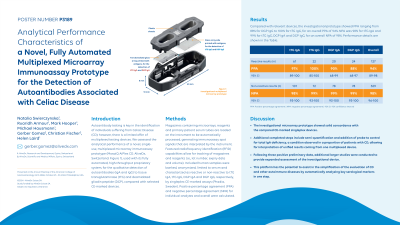Monday Poster Session
Category: Small Intestine
P3189 - Analytical Performance Characteristics of a Novel, Fully Automated Multiplexed Microarray Immunoassay Prototype for the Detection of Autoantibodies Associated with Celiac Disease
Monday, October 28, 2024
10:30 AM - 4:00 PM ET
Location: Exhibit Hall E

Has Audio

Gerber Gomez, MD, MSc
AliveDx
Eysins, Vaud, Switzerland
Presenting Author(s)
Natalia Swierczynska, BSc1, Ruaridh Armour, BSc1, Mark Hooper, BSc1, Michael Hausmann, BSc, PhD2, Gerber Gomez, MD, MSc2, Christian Fischer, MD, MSc2, Helen Laird, BSc1
1AliveDx, Edinburgh, Scotland, United Kingdom; 2AliveDx, Eysins, Vaud, Switzerland
Introduction: Autoantibody testing is key in the identification of individuals suffering from Celiac Disease (CD); however, there is a limited offer of multiplexed testing devices. We assessed the analytical performance of a novel, single-use, multiplexed microarray immunoassay prototype (MosaiQ® AiPlex CD. AliveDx, Switzerland), used with its fully automated high-throughput proprietary system, for the qualitative detection of autoantibodies (IgA and IgG isotypes), directed against tissue transglutaminase (tTG) and deamidated gliadin peptide (DGP), compared with selected CE-marked devices.
Methods: Magazines containing microarrays, reagents and primary patient serum tubes are loaded on the instrument to be automatically processed, generating immunoassay spot signals that are interpreted by the instrument. Featured radiofrequency identification (RFID) capabilities allow for tracking of magazines and reagents (i.e., lot number, expiry date and volume). Included human samples were banked, anonymized, limited to serum and characterized as reactive or non-reactive to tTG IgA, tTG IgG, DGP IgA and DGP IgG, respectively, by individual assays (Phadia, Sweden). Positive percentage agreement (PPA) and negative percentage agreement (NPA) for individual analytes and overall were calculated.
Results: Compared with relevant devices, the investigational prototype showed PPA ranging from 88% for DGP IgG to 100% for tTG IgG, for an overall PPA of 94%. NPA was 98% for tTG IgA and 99% for tTG IgG, DGP IgA and DGP IgG, for an overall NPA of 98%. Performance details are shown in the Table.
Discussion: The investigational microarray prototype showed solid concordance with the compared CE-marked singleplex devices. Ongoing steps include semi-quantification and addition of probe to control for total IgA deficiency, a condition observed in a proportion of patients with CD, allowing for interpretation of unified results coming from one multiplexed device. Following these positive preliminary data, additional larger studies are ongoing to provide expanded assessment of the investigational device. This platform has the potential to assist in the simplification of CD evaluation by automatically analyzing key serological markers.
Note: The table for this abstract can be viewed in the ePoster Gallery section of the ACG 2024 ePoster Site or in The American Journal of Gastroenterology's abstract supplement issue, both of which will be available starting October 27, 2024.
Disclosures:
Natalia Swierczynska, BSc1, Ruaridh Armour, BSc1, Mark Hooper, BSc1, Michael Hausmann, BSc, PhD2, Gerber Gomez, MD, MSc2, Christian Fischer, MD, MSc2, Helen Laird, BSc1. P3189 - Analytical Performance Characteristics of a Novel, Fully Automated Multiplexed Microarray Immunoassay Prototype for the Detection of Autoantibodies Associated with Celiac Disease, ACG 2024 Annual Scientific Meeting Abstracts. Philadelphia, PA: American College of Gastroenterology.
1AliveDx, Edinburgh, Scotland, United Kingdom; 2AliveDx, Eysins, Vaud, Switzerland
Introduction: Autoantibody testing is key in the identification of individuals suffering from Celiac Disease (CD); however, there is a limited offer of multiplexed testing devices. We assessed the analytical performance of a novel, single-use, multiplexed microarray immunoassay prototype (MosaiQ® AiPlex CD. AliveDx, Switzerland), used with its fully automated high-throughput proprietary system, for the qualitative detection of autoantibodies (IgA and IgG isotypes), directed against tissue transglutaminase (tTG) and deamidated gliadin peptide (DGP), compared with selected CE-marked devices.
Methods: Magazines containing microarrays, reagents and primary patient serum tubes are loaded on the instrument to be automatically processed, generating immunoassay spot signals that are interpreted by the instrument. Featured radiofrequency identification (RFID) capabilities allow for tracking of magazines and reagents (i.e., lot number, expiry date and volume). Included human samples were banked, anonymized, limited to serum and characterized as reactive or non-reactive to tTG IgA, tTG IgG, DGP IgA and DGP IgG, respectively, by individual assays (Phadia, Sweden). Positive percentage agreement (PPA) and negative percentage agreement (NPA) for individual analytes and overall were calculated.
Results: Compared with relevant devices, the investigational prototype showed PPA ranging from 88% for DGP IgG to 100% for tTG IgG, for an overall PPA of 94%. NPA was 98% for tTG IgA and 99% for tTG IgG, DGP IgA and DGP IgG, for an overall NPA of 98%. Performance details are shown in the Table.
Discussion: The investigational microarray prototype showed solid concordance with the compared CE-marked singleplex devices. Ongoing steps include semi-quantification and addition of probe to control for total IgA deficiency, a condition observed in a proportion of patients with CD, allowing for interpretation of unified results coming from one multiplexed device. Following these positive preliminary data, additional larger studies are ongoing to provide expanded assessment of the investigational device. This platform has the potential to assist in the simplification of CD evaluation by automatically analyzing key serological markers.
Note: The table for this abstract can be viewed in the ePoster Gallery section of the ACG 2024 ePoster Site or in The American Journal of Gastroenterology's abstract supplement issue, both of which will be available starting October 27, 2024.
Disclosures:
Natalia Swierczynska: AliveDx – Employee.
Ruaridh Armour: AliveDx – Employee.
Mark Hooper: AliveDx – Employee.
Michael Hausmann: Michael Hausmann – Employee.
Gerber Gomez: AliveDx – Employee.
Christian Fischer: AliveDx – Employee.
Helen Laird: AliveDx – Employee.
Natalia Swierczynska, BSc1, Ruaridh Armour, BSc1, Mark Hooper, BSc1, Michael Hausmann, BSc, PhD2, Gerber Gomez, MD, MSc2, Christian Fischer, MD, MSc2, Helen Laird, BSc1. P3189 - Analytical Performance Characteristics of a Novel, Fully Automated Multiplexed Microarray Immunoassay Prototype for the Detection of Autoantibodies Associated with Celiac Disease, ACG 2024 Annual Scientific Meeting Abstracts. Philadelphia, PA: American College of Gastroenterology.
